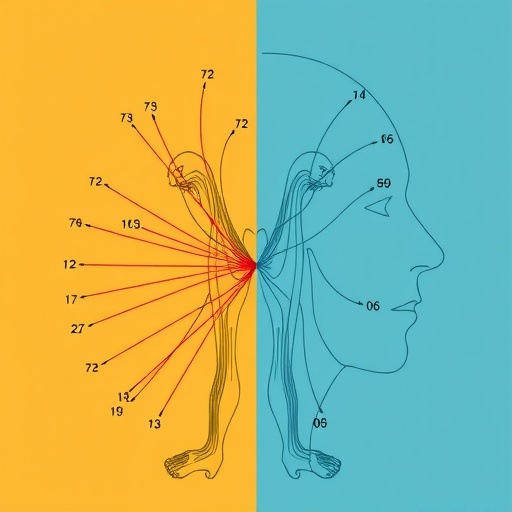PROTECT YOUR DNA WITH QUANTUM TECHNOLOGY
Orgo-Life the new way to the future Advertising by Adpathway
Researchers at Tel Aviv University have made significant strides in the field of photonics by introducing a groundbreaking technique known as photonic origami. This pioneering approach allows scientists to fold ultra-thin glass sheets into intricate three-dimensional optical structures directly on silicon chips. The implications of this innovation are vast, providing a pathway toward creating complex optical devices that are not only tiny but also capable of high-performance data processing and sensing applications.
Traditional 3D printing technology has long been hindered by the rough surface finish of the printed structures. These imperfections restrict their use in high-performance optics, where precision is paramount. In contrast, the research team has developed a method that hinges on the natural processes inspired by nature—specifically, the mechanics of a pinecone’s scales as they open. By using a laser-induced folding technique, they manipulate ultrathin glass sheets, allowing for the creation of highly transparent and exceptionally smooth optical devices capable of real-world applications.
In a recent publication in the journal Optica, the researchers delve into the details of their laser-induced folding technique, which achieves a remarkable length-to-thickness ratio for 3D structures. They can now fabricate structures measuring up to 3 mm in length yet just 0.5 microns thick, or around 1/200th the diameter of a human hair. This exceptional precision ensures that the crafted optical resonators and mirrors have a surface variance of less than a nanometer, allowing light to reflect without distortion—a feat previously considered unattainable for such small-scale devices.
.adsslot_rcoZ8G9pWz{width:728px !important;height:90px !important;}
@media(max-width:1199px){ .adsslot_rcoZ8G9pWz{width:468px !important;height:60px !important;}
}
@media(max-width:767px){ .adsslot_rcoZ8G9pWz{width:320px !important;height:50px !important;}
}
ADVERTISEMENT
The implications of these findings extend beyond mere optical improvements. Tal Carmon, the team leader, highlights the technique’s potential to develop micro-zoom lenses that could revolutionize smartphone cameras, replacing the need for multiple lenses with a single, compact unit. This transition could spearhead advancements not only in mobile photography but also in a broad range of microphotonic components that capitalize on light instead of electricity, positioning them as superior alternatives in the ever-evolving landscape of electronic devices.
Interestingly, the discovery of this photonic origami technique was serendipitous. It arose during a routine experiment when graduate student Manya Malhotra was tasked with locating a laser’s impact point on glass. Instead of merely glowing as anticipated, the glass began to fold under the heat, revealing a new and unexpected method for manipulating glass. Malhotra has since become a specialist in this niche research area, showcasing how chance encounters in science often lead to significant breakthroughs.
The mechanics behind photonic origami are fascinating. When the researchers direct a laser at a specific point on the glass, they induce a local heating effect that liquefies the glass. This change in state increases the surface tension, counteracting the force of gravity and allowing the glass to bend precisely at the area directly affected by the laser. This controlled folding happens in an astonishingly brief time, with the entire process completed within milliseconds and achieving fold speeds of up to 2 meters per second.
Moreover, the versatility of this technique shines through as the researchers successfully produced complex structures, including helices and various mirror forms. The most remarkable of these is a lightweight table featuring a concave mirror—designed for applications in cutting-edge experimental physics. Inspired by theoretical frameworks suggesting the exploration of deviations from Newtonian gravity at micro-scales, this table, crafted from a 5-micron thick glass sheet, exemplifies the innovative capabilities of photonic origami.
The researchers believe that the lightweight table could theoretically be optically levitated, opening avenues to explore gravitational phenomena that remain mysterious, particularly in the context of dark matter. Given that these experiments may yield insights into fundamental physics, the potential for collaboration between photonics and astrophysics is not only exciting but also pivotal in addressing longstanding questions that challenge our current understanding of the universe.
Carmon states that achieving high-performance, three-dimensional microphotonic applications has been a long-sought goal within the scientific community. The advent of photonic origami has moved the field of silica photonics—utilizing glass to control light—into uncharted territory, thereby unlocking new possibilities for integrated optical devices. The combination of intricate design and high functionality positions this technology at the forefront of scientific research and product development.
In summary, the development of photonic origami represents a significant milestone in optical engineering and materials science. The researchers’ ability to manipulate the fundamental properties of glass on a micro-scale opens new doors for applications across various domains, from data processing to experimental physics. Their work not only enhances the capabilities of photonic systems but also signifies a substantial leap towards the fusion of traditional optics with advanced material manipulation technologies.
The pathway forward is exciting, as this new method lays the groundwork for future innovations in optics, with potential implications for the design of everything from consumer electronics to advanced scientific instruments. As the researchers continue to explore the dualities of creativity and precision in optical structure fabrication, the legacy of photonic origami will likely contribute to a broader understanding of light manipulation and interaction within engineered systems.
The researchers conclude that this method represents a promising frontier in the synthesis of new optical materials and devices, which might ultimately lead to the creation of the next generation of photonic technologies that could reshape our interaction with light and its applications in the modern world.
Subject of Research: Photonic Origami Techniques
Article Title: Photonic Origami of Silica on a Silicon Chip with Microresonators and Concave Mirrors
News Publication Date: October 2023
Web References: https://opg.optica.org/optica/home.cfm, https://english.tau.ac.il/
References: M. Malhotra, R. Ben-Daniel, F. Cheng, T. Carmon, “Photonic Origami of Silica on a Silicon Chip with Microresonators and Concave Mirrors,” 12, (2025). DOI: 10.1364/OPTICA.560597
Image Credits: Tal Carmon, Tel Aviv University
Keywords
Optical devices, Glass, Lenses, Applied physics
Tags: 3D optical devices fabricationdata processing in photonicshigh-performance optics applicationsinnovative photonics methodslaser-induced folding techniquemicroscopic optical devices developmentnature-inspired engineeringphotonic origami technologyprecision optical structuressmooth surface finish in opticsTel Aviv University researchultra-thin glass structures


 2 months ago
24
2 months ago
24





















 English (US) ·
English (US) ·  French (CA) ·
French (CA) ·